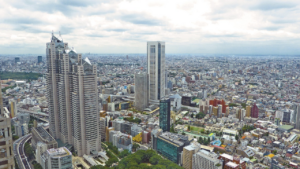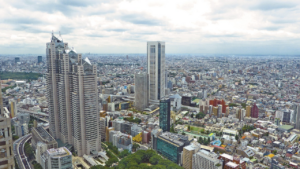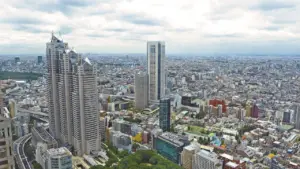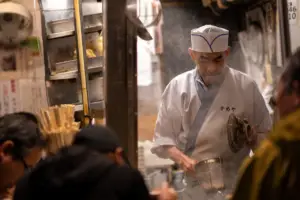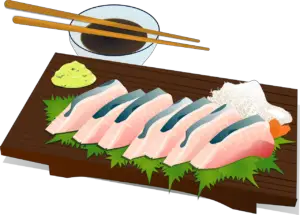Tokyo, the bustling capital city of Japan, is a melting pot of cultures, traditions, and flavors. Its culinary scene is renowned worldwide for its exceptional variety, quality, and innovation. From traditional Japanese dishes to international cuisine, Tokyo has it all. This article aims to take you on a culinary journey through the city, exploring its most iconic food and dining experiences.
One of the most famous and beloved cuisines in Tokyo is sushi. This delicacy originated in Japan and has become one of the most popular foods worldwide. Tokyo is home to some of the best sushi restaurants in the world, offering a range of styles from classic to modern.
Another popular dish that has taken the world by storm is ramen, a hearty noodle soup that comes in many variations. Tokyo is where ramen lovers can indulge in some of the most flavorful and authentic ramen dishes, from shio (salt) to miso (soybean paste) to tonkotsu (pork bone) broth.
Whether you are a foodie or just looking to experience something new, Tokyo cuisine is a must-try for anyone visiting the city.
Key Takeaways
- Tokyo’s culinary scene is renowned worldwide for its variety, quality, and innovation.
- Ramen and sushi are popular dishes, with Tokyo being home to some of the world’s most famous and innovative ramen shops.
- Izakaya, Japanese gastropubs, are a popular dining option, offering small plates and drinks for sharing and socializing.
- Kaiseki, a traditional multi-course dining experience, is a highly sought-after experience for food enthusiasts, designed to evoke a sense of harmony and balance.
Sushi
Sushi, a traditional Japanese dish made of vinegared rice and various toppings such as raw fish or vegetables, is highly regarded for its delicate balance of flavors and textures. The origin of sushi is believed to date back to the 2nd century AD, when people in Southeast Asia preserved fish in fermented rice.
Over the centuries, sushi evolved into the dish that is now enjoyed worldwide.
The key to a good sushi experience lies in the quality of the ingredients and the skill of the chef. The rice used in sushi is short-grained, sticky, and seasoned with vinegar, sugar, and salt. The fish, which is usually served raw, must be fresh, and the texture and taste of the fish should complement the rice.
The chef must also know how to cut the fish properly to enhance its flavor and texture.
Overall, sushi is a dish that requires precision and attention to detail to create a harmonious blend of flavors and textures that is both satisfying and delicious.
Ramen
Ramen, a popular Japanese dish, has a long history in Tokyo dating back to the early 20th century when it was introduced by Chinese immigrants.
Today, Tokyo is known for having some of the best ramen restaurants in the world, each with their unique take on the dish.
Regional variations of ramen can also be found in Tokyo, with each region showcasing its distinct flavor and style.
This discussion will delve into the history of ramen in Tokyo, explore some of the best ramen restaurants in the city, and examine the regional variations of this beloved dish.
History of Ramen in Tokyo
Tokyo’s culinary scene has a rich history, and one notable aspect of it is the evolution of ramen in the city. Ramen is a noodle soup dish that originated in China and was brought to Japan in the late 1800s. Over time, ramen has become a staple food in Japan, with different regions having their own unique variations. Tokyo, in particular, has played a significant role in the development of ramen.
Here are some key points that highlight the history of ramen in Tokyo:
-
Ramen shops started becoming popular in Tokyo in the early 1900s, with the first documented ramen shop opening in Asakusa in 1910.
-
During World War II, ramen became a popular and affordable food option for the masses due to food shortages.
-
In the post-war period, ramen underwent a transformation in Tokyo, with new ingredients and cooking methods being introduced.
-
Today, Tokyo is home to some of the world’s most famous and innovative ramen shops, with many chefs experimenting with different flavors and techniques to create unique and delicious bowls of ramen.
Best Ramen Restaurants
Amidst the diverse culinary offerings of Japan’s capital city, ramen enthusiasts can indulge in the best of the best at some of the top-rated ramen restaurants. Tokyo is home to countless ramen shops, each with its own unique take on this classic dish.
Some of the best ramen restaurants in Tokyo include Ichiran, Tsuta, and Nakiryu. Ichiran is one of the most well-known ramen chains in Japan, with several locations throughout Tokyo. The restaurant is known for its tonkotsu ramen, which is made from pork bones that have been simmered for hours to create a rich, creamy broth. Ichiran’s ramen is served with thin, chewy noodles and a variety of toppings, including sliced pork, green onions, and mushrooms.
Customers can customize their orders by selecting the level of spiciness, richness, and garlic flavor they prefer. With its cozy booths and personalized ordering system, Ichiran is a must-visit for any ramen lover in Tokyo.
Regional Variations of Ramen
One can explore the rich diversity of Japan’s regional cuisine by sampling the various regional variations of ramen. Each region in Japan has its own distinct style of preparing ramen, which is influenced by the local culture and ingredients.
Here are some examples of regional variations of ramen that one should definitely try:
-
Sapporo Ramen: This style of ramen originated in Hokkaido, the northernmost island of Japan. It is characterized by a rich, miso-based broth and thick, curly noodles that are cooked al dente. The toppings typically include butter, sweet corn, and slices of roast pork.
-
Hakata Ramen: This style of ramen originated in Fukuoka, the southernmost island of Japan. It is characterized by a milky, pork-bone broth and thin, straight noodles that are cooked until they are soft and chewy. The toppings typically include slices of roast pork, green onions, and pickled ginger.
-
Tokyo Ramen: This style of ramen originated in Tokyo, the capital city of Japan. It is characterized by a clear, soy sauce-based broth and thin, curly noodles that are cooked until they are firm. The toppings typically include slices of roast pork, bamboo shoots, and nori (dried seaweed).
By trying out these different regional variations of ramen, one can gain a deeper understanding and appreciation for the diversity of Japanese cuisine. Each style of ramen has its own unique flavor profile and texture, which reflects the local ingredients and culinary traditions of the region.
Tempura
Originating in Portuguese cuisine, tempura has become a beloved dish in Tokyo’s culinary scene. This deep-fried dish is made by coating vegetables or seafood in a light batter and frying them in hot oil until they become crispy and golden brown. While tempura is now associated with Japanese cuisine, it was actually introduced to Japan by Portuguese traders in the 16th century.
Over time, Japanese chefs adapted the dish by using local ingredients and creating their own unique batter recipes. One of the reasons why tempura is so popular in Tokyo is its versatility. It can be served as a main dish, a side dish, or even as a topping for rice bowls. Additionally, the light and crispy texture of tempura makes it a great pairing with a variety of dipping sauces, such as soy sauce, tentsuyu, or grated daikon.
Some of the most popular ingredients used in tempura in Tokyo include shrimp, squid, eggplant, sweet potato, and shiitake mushrooms. When prepared correctly, the batter should be light and airy, allowing the natural flavors of the ingredients to shine through. Overall, tempura is a must-try dish for anyone visiting Tokyo who wants to experience the city’s diverse culinary scene.
Street Food
Street food is a ubiquitous aspect of dining culture in Tokyo, offering a diverse array of portable and affordable options for locals and tourists alike. Here are three examples of Tokyo’s most popular street food:
-
Takoyaki: These small balls of batter are filled with diced octopus, green onion, and pickled ginger, then topped with mayonnaise and savory sauce. Takoyaki is often found at festivals and street fairs, where vendors cook them fresh on a griddle and serve them piping hot.
-
Yakitori: Skewered chicken cooked over a charcoal grill, Yakitori is a staple of Tokyo’s street food scene. Vendors often offer a variety of cuts, from chicken wings to thigh to liver, all seasoned with salt and pepper or basted with a sweet soy sauce.
-
Okonomiyaki: Often referred to as a ‘Japanese pancake,’Okonomiyaki is a savory dish made with a batter of flour, eggs, and shredded cabbage. Additional ingredients such as meat, seafood, or cheese can be added, then it is cooked on a griddle and topped with sauce and mayonnaise. Okonomiyaki is a popular street food item in Tokyo’s Shibuya and Harajuku neighborhoods.
Tokyo’s street food scene is a reflection of the city’s vibrant and diverse culinary culture. From savory takoyaki to grilled yakitori to hearty okonomiyaki, these portable and affordable options offer a taste of Japan’s rich food traditions to visitors and locals alike.
Izakaya
Izakaya, Japanese gastropubs, have become an integral part of Tokyo’s culinary scene.
These informal establishments offer a wide range of drinks and small plates, including grilled meats, seafood, and vegetables.
With an abundance of options to choose from, it can be challenging to find the best Izakaya in Tokyo.
Japanese Gastropubs
Japanese gastropubs, also known as ‘izakaya,’ are a popular dining option in Tokyo. These establishments offer a wide variety of small plates and drinks that are perfect for sharing and socializing with friends and colleagues after work. The menu typically features a range of dishes, from grilled skewers and tempura to sushi and sashimi. The emphasis is on fresh, high-quality ingredients and simple, yet flavorful preparations.
In addition to food, izakaya also serve a variety of drinks, including beer, sake, and shochu. Some even offer a selection of cocktails and wine. One of the unique aspects of Japanese gastropubs is their lively atmosphere. The decor is often casual and welcoming, with a mix of bar seating and tables. Patrons are encouraged to linger and enjoy themselves, with many izakaya staying open late into the night.
Many establishments also feature private rooms, making them a popular choice for corporate events and parties. Overall, Japanese gastropubs offer a fun and relaxed dining experience that is perfect for those looking to unwind after a long day.
Drinks and Small Plates
Japanese gastropubs are a popular and cherished aspect of Tokyo’s culinary scene, offering a unique experience that perfectly blends traditional Japanese cuisine with modern twists. The food is often served in small plates, perfect for sharing and tasting a variety of dishes. However, it’s not just the food that makes these gastropubs so special. The drinks served are also a highlight, with a wide selection of sake, shochu, and craft beers available.
But what happens when you combine these two elements into one experience? That’s where the current subtopic comes in – drinks and small plates.
At many Japanese gastropubs, drinks and small plates go hand in hand. It’s common to order a few dishes to share with friends while pairing them with a refreshing beverage. This combination creates a unique culinary experience that allows you to explore different flavors and textures.
Here are a few examples of the drinks and small plates that you might encounter at a Tokyo gastropub:
- Yakitori skewers paired with ice-cold beer
- Tempura shrimp served with a glass of crisp white wine
- Grilled tofu paired with a smooth and creamy sake
- Takoyaki (octopus balls) served with a refreshing shochu highball
- Spicy edamame paired with a fruity and refreshing cocktail
Overall, drinks and small plates are an essential part of the Tokyo gastropub experience. By combining delicious food with refreshing drinks, you can explore the many flavors of Japanese cuisine in a unique and exciting way.
Best Izakaya in Tokyo
For those seeking a unique and memorable dining experience in the heart of Japan, exploring the diverse selection of gastropubs in the city is a must. Known as izakaya, these casual, lively establishments offer a wide variety of small plates, grilled items, and drinks, making them the perfect destination for a night out with friends or colleagues. While there are countless izakaya scattered throughout Tokyo, some stand out for their exceptional food quality, atmosphere, and service.
One of the top izakaya in Tokyo is Toritake, located in the bustling Shibuya district. This establishment specializes in yakitori, or grilled chicken skewers, and sources their ingredients from local farmers to ensure the highest quality. The menu also features a range of other grilled items, such as pork belly and vegetables, as well as a selection of Japanese sake and shochu. The ambiance is cozy and inviting, with wooden decor and a lively atmosphere that is perfect for groups. Another highly recommended izakaya is Omoide Yokocho, also known as Memory Lane, in Shinjuku. This narrow alleyway is lined with tiny restaurants and bars, each with their own unique character. Visitors can enjoy a variety of small plates, from grilled meats and seafood to noodles and rice dishes, and sample local beers and sake. The atmosphere is bustling and energetic, with friendly staff and a true sense of Tokyo’s vibrant nightlife.
Kaiseki
A traditional multi-course dining experience, Kaiseki is a culinary art form that showcases the flavors of the season and the skills of the chef. In Tokyo, Kaiseki dining is a popular and highly sought-after experience for food enthusiasts. The meal consists of a series of small, beautifully presented dishes that are carefully crafted with attention to detail and flavor.
To fully appreciate Kaiseki dining, one must understand the philosophy behind it. The meal is intended to evoke a sense of harmony and balance between the food, the environment, and the diner. The chef carefully selects ingredients that reflect the season and the local environment, ensuring that the flavors are at their peak.
The meal is also designed to be a visual feast, with each dish presented in an aesthetically pleasing manner. Overall, Kaiseki dining is a true culinary journey that allows diners to experience the essence of Japanese cuisine.
- The meal is designed to evoke a sense of harmony and balance between the food, the environment, and the diner.
- Ingredients are carefully selected to reflect the season and the local environment.
- The meal is presented in an aesthetically pleasing manner, making it a visual feast.
- Kaiseki dining is a true culinary journey that allows diners to experience the essence of Japanese cuisine.
Dining Experiences
Dining experiences in Japan offer a unique opportunity to explore the country’s rich culinary traditions and sample a diverse range of dishes. Tokyo, in particular, is home to a variety of dining experiences that cater to different tastes and preferences. From traditional kaiseki meals to contemporary fusion cuisine, Tokyo’s culinary scene is an adventure in itself.
One of the most popular dining experiences in Tokyo is the izakaya, a type of casual Japanese pub that serves a variety of small dishes to accompany drinks. Izakayas are known for their lively atmosphere and social nature, making them a great place to meet friends and enjoy a casual evening out. Another unique dining experience is the robot restaurant, a futuristic-themed venue that features robot performances and flashy neon lights along with a menu of Japanese and Western fusion dishes. Finally, for a more traditional Japanese dining experience, visitors can try a teppanyaki meal, where a chef cooks meat, seafood, and vegetables on a hot iron griddle directly in front of the customers. This interactive and theatrical style of dining is a must-try for anyone visiting Tokyo.
| Dining Experience | Description | Pros | Cons | |||||
|---|---|---|---|---|---|---|---|---|
| Izakaya | Casual Japanese pub | Social atmosphere, variety of small dishes | Can be noisy and crowded | |||||
| Robot Restaurant | Futuristic-themed restaurant with robot performances | Unique experience, fun atmosphere | Can be expensive, not for everyone | |||||
| Teppanyaki | Chef cooks food on hot iron griddle in front of customers | Interactive and theatrical, delicious food | Can be pricey, not for those who prefer a quiet atmosphere | Sports bar | Ideal for sports enthusiasts, lively and casual atmosphere | Great for watching games and socializing, variety of food and drinks | May not be suitable for those who dislike loud noise and crowds |
Frequently Asked Questions
What is the history of sushi in Tokyo and how has it evolved over time?
Sushi has a long and rich history in Tokyo, dating back to the 19th century. Originally, sushi was a fast food for the working class, and was sold on the streets by itinerant vendors.
However, in the early 20th century, sushi evolved into a more refined and elegant cuisine, as Tokyo’s middle class began to appreciate the artistry and craftsmanship of sushi chefs.
Today, Tokyo is considered to be the sushi capital of the world, with an abundance of high-end sushi restaurants and a thriving sushi culture.
Sushi in Tokyo has continued to evolve over time, with new techniques and ingredients being introduced to keep the cuisine fresh and exciting.
Despite its long history, sushi in Tokyo remains a beloved and integral part of the city’s culinary landscape.
Can you recommend any vegetarian or vegan ramen options in the city?
There are several vegetarian and vegan ramen options available in Tokyo, catering to the growing demand for plant-based diets.
One option is T’s Tantan, a vegan ramen chain with multiple locations in the city. Their ramen is made with a soy milk-based broth and a variety of vegetables, providing a rich and satisfying flavor.
Another option is Afuri, a popular ramen chain with a vegetarian option made with a shiitake mushroom-based broth.
For those looking for a more unique experience, Soranoiro NIPPON offers a tomato-based vegan ramen with a variety of toppings.
Overall, Tokyo has a diverse range of culinary offerings, including options for vegetarians and vegans, making it a great destination for foodies of all dietary preferences.
What are some of the lesser-known types of tempura that can be found in Tokyo?
Tempura is a popular dish in Tokyo that consists of battered and deep-fried seafood and vegetables. While shrimp and vegetables such as sweet potato and pumpkin are commonly used, there are also lesser-known types of tempura that can be found in the city.
One such type is ‘shirako’, or cod milt, which is the sperm of the male fish and has a creamy texture. Another is ‘yuba’, which is the skin that forms on top of heated soy milk and has a delicate flavor. ‘Kakiage’is a type of tempura that is made by mixing different types of vegetables together and frying them in a ball shape.
Tempura can be found in various restaurants across Tokyo, ranging from upscale to more casual settings, and is often enjoyed with a dipping sauce made of soy sauce and grated daikon radish.
Are there any specific street food markets or areas that are particularly popular among locals?
There are a variety of street food markets and areas that are popular among locals in Tokyo.
One of the most well-known is the Tsukiji Outer Market, which is a bustling hub of food vendors selling fresh seafood, sushi, and various other Japanese delicacies.
Another popular spot is the Ameyoko Market in Ueno, which offers a wide range of street foods such as yakitori, takoyaki, and gyoza.
The Nakamise Shopping Street in Asakusa is also a popular destination, offering traditional Japanese snacks such as senbei, dango, and manju.
Each of these areas offers a unique culinary experience, allowing visitors to sample a variety of local foods while immersing themselves in Tokyo’s vibrant street culture.
What is the etiquette for dining at an izakaya and what types of dishes are typically served?
Dining at an izakaya involves adhering to certain etiquette. It is customary to remove one’s shoes and sit on the floor, with legs crossed or folded to one side.
Sharing dishes is common, as is ordering a variety of small plates to try. It is also polite to order drinks for the table, and to pour drinks for others rather than oneself.
As for the types of dishes served, izakayas typically offer a wide range of options, including grilled skewers, sashimi, tempura, and other small plates. Many izakayas also offer larger dishes such as noodle soups or rice bowls.
The atmosphere is usually casual and lively, making it a popular spot for socializing and after-work gatherings.
Conclusion
Tokyo’s culinary scene is a journey through the city’s history and culture. From the elegant kaiseki dining experiences to the bustling street food stalls, Tokyo offers a wide range of flavors and textures that cater to all tastes.
Sushi is undoubtedly the most famous dish in Tokyo, with countless sushi bars offering fresh and delicious seafood. Ramen, on the other hand, is a comfort food that can be enjoyed in various styles, from the classic shoyu ramen to the spicy tantanmen. Tempura is another staple in Tokyo cuisine, with light and crispy batter coating fresh seafood and vegetables.
For those who prefer something quick and easy, Tokyo’s street food scene is a must-try, with yakitori, takoyaki, and okonomiyaki being the most popular choices. Izakaya, the Japanese version of a gastropub, offers a more relaxed atmosphere where customers can enjoy a variety of small plates and drinks.
Finally, the kaiseki dining experience is a true reflection of Tokyo’s fine dining scene, with multi-course meals carefully prepared and presented with precision and elegance. Tokyo’s culinary scene is not just about the food, but also about the atmosphere and experience that each restaurant offers. Whether it’s a cozy ramen joint or a high-end sushi bar, Tokyo’s cuisine is a journey that should not be missed.






























